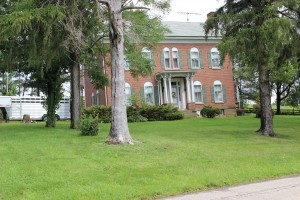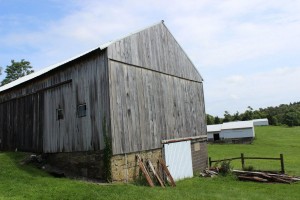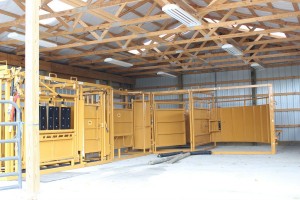(Editor’s note: As part of our 100-year anniversary celebration, we continue our 10-week series profiling some of the region’s farms that have been in the same family for 200 or more years. These are the farm roots that run deep, and we’re proud to salute them — and others — as we start our next 100 years.)
BRIDGEPORT, Ohio — Richard Theaker’s first ancestors in Ohio were blacksmiths by trade, making their way from York, Pennsylvania, “across the mountains,” in Theaker’s words, near the turn of the 19th century.
Much of Belmont County in southeastern Ohio, where the early Theakers landed, was Indian territory until 1791, and the deed to the first Theaker property in Ohio was, in fact, written on sheepskin.
In 1808, Richard’s great-great-grandfather, John Theaker, left that first Ohio home near Short Creek Township formerly known as Morning Glow, purchasing a property on Farmington Road, south of Colerain Township.
He set up a blacksmith shop, but over the next century and a half, the Theaker farm would become known as a dairy operation.
It was originally 200 acres, Richard Theaker said. “We knew by gravestones on the property that it was 100 years old, but we were surprised to find out it was 200.”

Remnants of John Theaker’s first dwelling on the farm remain, but the main farm house — a three-story, six-bedroom, brick home — was completed in 1871.
The bricks were formed on the property, adds Richard’s son, Richard Theaker II.
“Far back, I’d say somebody must have had some money,” he said of the house, which his grandmother lived in until her death only a few years ago. “There is a spiral staircase to the attic, which is closed off now, but there used to be a ballroom up there. We have found Bibles from the 1800s. It’s like a museum.”
The bank barn, dating from the same decade as the house, also remains. Massive timbers on both levels of the structure, along with the pulley system used to pull loose hay off wagons and into hay mows inside the barn, silently tell the farm’s two-century story.
Richard Theaker II pointed out one of the timbers, in the lower level of the barn formerly used for milking. The beam was cut from a branched section of a tree, and that natural split remains.

“They found a long enough piece and just left it that way,” he laughed. “I can’t even imagine the manpower — first to find a timber that straight, then say ‘I’m going to carry this whole beam.’”
Changing times
The dairy operation came to an end in the late 1950s, as the industry transitioned from milk cans to bulk tanks, and bulk loads of milk began being transported by tanker truck.
“We were going to have to get more cattle, too, and put more money into it,” said the elder Theaker. “So we went to raising beef.”
A decade earlier, however, Richard’s father, John Mansell Theaker, somewhat accidentally made an even more important business decision. Mansell, as he was known, bought a bulldozer to clean up around the farm.
Word spread quickly, and soon Mansell Theaker was getting more and more construction equipment and business.
Today, Theaker Excavating is a thriving business with 15 employees.
“And it doesn’t hurt to have this excavating equipment on a farm,” Richard Theaker added.

The family raises 50 head of cattle and calves a year, and installed a new cattle handling system in one of the farm’s newer barns. The series of gates and pens inside a lighted barn with a full concrete floor allows a much smoother vaccination process, Richard II explained.
A hoop barn across the pasture from the handling barn was built three years ago, he said, and has already reduced annual hay spoilage immensely.
“You really have to be in tune with the animals,” he said. “If I could make a living doing nothing but farming, I would.”
Back home
Richard Theaker just turned 69. He can remember, as a boy, when the a horse stable and a hog pen stood where the Theaker Excavating offices are now located.
“I remember the last horse on the farm,” he said. “And it used to take a team of people to do hay and threshing. It was a dirty job, but I enjoyed it.”
Meanwhile, Richard II left home after high school to attend the University of Akron, where he earned a degree in engineering, married and started a family. But after 10 years living and working in Canton, he and his wife, Jennifer, an avowed city girl, moved to rural Belmont County.
“It’s a blessing to still be here, to have made it through the Great Depression and everything,” Richard II said of the both the history of the farm and his own return to it. “I’m amazed that the property is not down to a subdivision. We are fortunate our ancestors had more in mind than making money or it would all be sold off.”

His father was even more to the point.
“I don’t know what it would have been if he hadn’t come back — a golf course maybe,” he said.
The future. All three of Richard and Jennifer’s children, Kayla, Ryan and Jacob, are active in 4-H. His family built a house down the road from the farm when they moved back to the area.
“This is the environment we wanted to bring the kids up in,” he said. “I’ve had two lives, so I want my kids to have that opportunity, too.
“They may leave and never come back, but they will at least respect this part.”
Learn about your local farmers by getting
Around the Table.
It's a FREE weekly e-newsletter all about food. Sign Up Today!
















A great story about a great family.